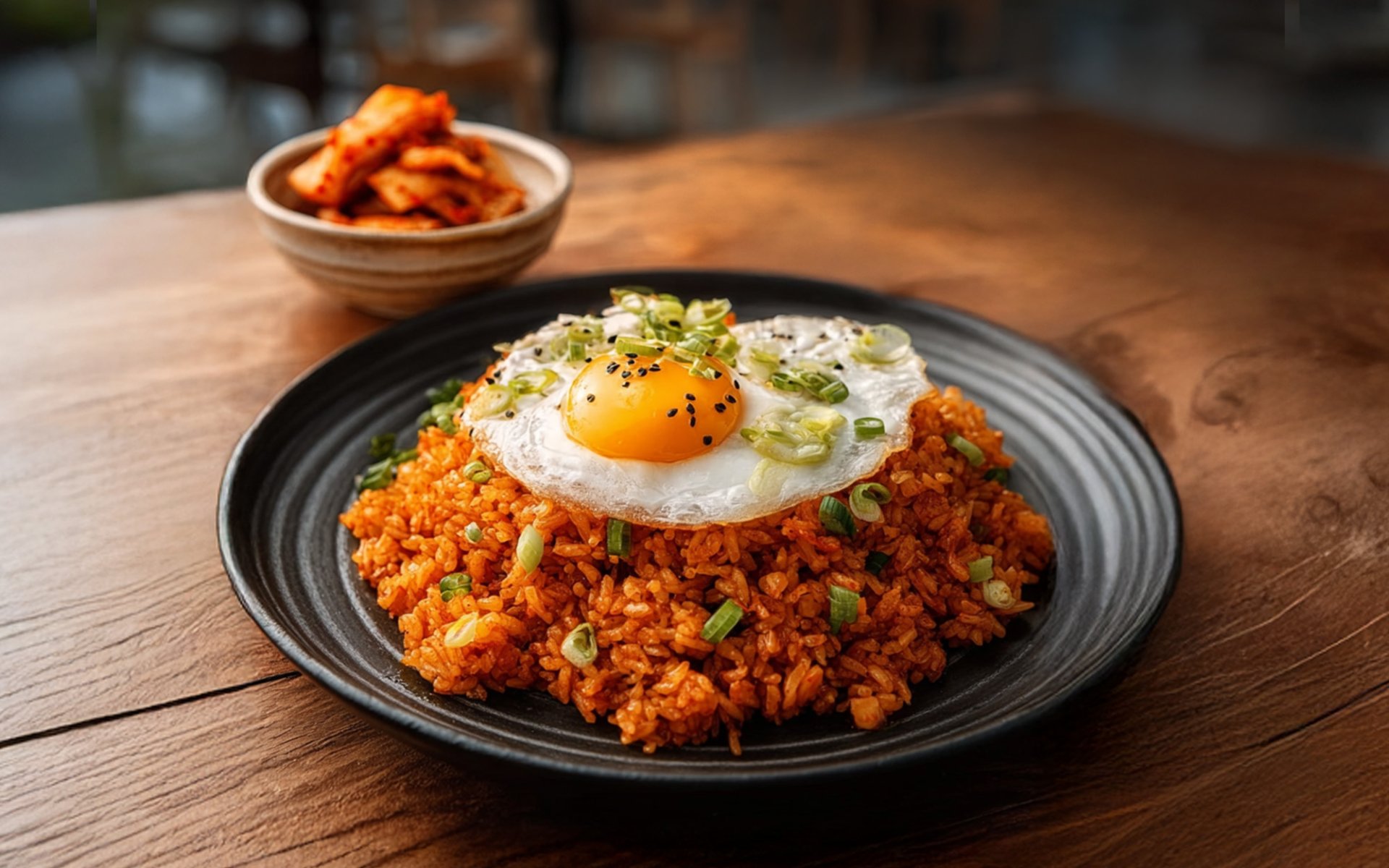Bokkeumbap (김치볶음밥)
Last updated: 15 Sept 2025

Kimchi Bokkeumbap (김치볶음밥), also known as Kimchi Fried Rice, is one of South Koreas most popular everyday dishes. It is made primarily with steamed rice and kimchi, but additional ingredients such as meat, onions, carrots, or tofu can be added depending on preference. The dish is commonly served with a fried egg on top and garnished with chopped scallions, roasted seaweed, or toasted sesame seeds.
The word Bokkeumbap comes from two Korean words: Bokkeum (볶음), meaning stir-fried, and Bap (밥), meaning cooked rice. Together, it translates to stir-fried rice. Adding Kimchi simply indicates that kimchi is the key ingredient, giving the dish its distinct flavor.
Today, it has evolved into a beloved quick meal, especially popular among busy workers who need something fast, hearty, and satisfying. Kimchi Bokkeumbap is now a staple on menus at Korean restaurants, particularly in Han-sik (한식, traditional Korean dining) establishments.
At many restaurants, it is often ordered as the final dish of a meal. Customers may say 밥 볶아 주세요 (Bap Bokkeo Juseyo), meaning Please fry the rice, asking the chef to use the leftover broth and seasonings from the main course to fry with riceresulting in a uniquely flavorful fried rice.
A famous Korean chef once shared a story: when his son returned home from college dorm life and was asked what food he missed most, his answer was simplyKimchi Bokkeumbap. This illustrates the strong emotional connection Koreans have with this humble dish.
This international spread of Kimchi Bokkeumbap not only introduces the flavors of Korean cuisine but also offers insight into Korean culture and everyday life.
Despite these variations, the basic philosophy of the dish remains the same: making something delicious out of simple, leftover ingredients.
For those who would like to try cooking Kimchi Bokkeumbap at home, all the essential ingredients are available at Rimping Supermarket.
Origins Making the Most of Leftovers
Like many traditional Korean dishes, Kimchi Bokkeumbap was born out of the simple idea of making full use of available ingredients. In the past, Korean families made kimchi in large quantities to last throughout the year. When they had surplus kimchi, they would use it as the main ingredient in various recipesincluding Kimchi Bokkeumbap.The word Bokkeumbap comes from two Korean words: Bokkeum (볶음), meaning stir-fried, and Bap (밥), meaning cooked rice. Together, it translates to stir-fried rice. Adding Kimchi simply indicates that kimchi is the key ingredient, giving the dish its distinct flavor.
From a Simple Home Dish to a National Favorite
In the past, Kimchi Bokkeumbap was a practical meal made with whatever ingredients were on handleftover rice, kimchi, pork, onions, and assorted vegetables. It became a clever way to avoid food waste while still creating a flavorful and filling dish.Today, it has evolved into a beloved quick meal, especially popular among busy workers who need something fast, hearty, and satisfying. Kimchi Bokkeumbap is now a staple on menus at Korean restaurants, particularly in Han-sik (한식, traditional Korean dining) establishments.
At many restaurants, it is often ordered as the final dish of a meal. Customers may say 밥 볶아 주세요 (Bap Bokkeo Juseyo), meaning Please fry the rice, asking the chef to use the leftover broth and seasonings from the main course to fry with riceresulting in a uniquely flavorful fried rice.
A Comfort Food for Students and Singles
Kimchi Bokkeumbap is especially popular among university students living in dormitories and people who live alone. It requires minimal cooking skills but delivers rich flavor and comfort.A famous Korean chef once shared a story: when his son returned home from college dorm life and was asked what food he missed most, his answer was simplyKimchi Bokkeumbap. This illustrates the strong emotional connection Koreans have with this humble dish.
Global Popularity Through the Korean Wave
With the global rise of the Korean Wave (Hallyu), Kimchi Bokkeumbap has gained international recognition. Its straightforward cooking process and unique flavor have made it popular among people worldwide. Korean restaurants across the globe often feature it as a signature dish, while countless online tutorials make it accessible to home cooks everywhere.This international spread of Kimchi Bokkeumbap not only introduces the flavors of Korean cuisine but also offers insight into Korean culture and everyday life.
Modern Adaptations
In modern kitchens, Kimchi Bokkeumbap has become even more convenient to prepare. Many people now use ready-made kimchi from stores rather than fermenting it at home. Some also enhance the dish with sauces like gochujang (Korean chili paste) or soy sauce to intensify the flavor.Despite these variations, the basic philosophy of the dish remains the same: making something delicious out of simple, leftover ingredients.
For those who would like to try cooking Kimchi Bokkeumbap at home, all the essential ingredients are available at Rimping Supermarket.
Related Content
Getting to Know Potato Dumplings A Dish Highly Popular Across Central and Eastern Europe


